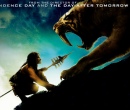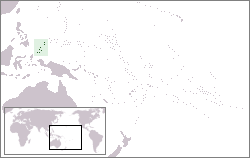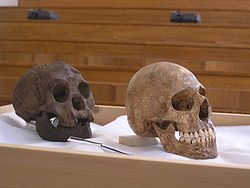 You might have heard of a movie called “10,000 BC” coming out in March of 2008. If you saw the trailers you might have noticed some things that were inaccurate, or at least grossly exaggerated, if you have some basic knowledge of prehistory. Were saber-tooth tigers (smilodons) really that big? Did they really have sailboats, domesticated mammoths and cities back in 10,000 BC?
You might have heard of a movie called “10,000 BC” coming out in March of 2008. If you saw the trailers you might have noticed some things that were inaccurate, or at least grossly exaggerated, if you have some basic knowledge of prehistory. Were saber-tooth tigers (smilodons) really that big? Did they really have sailboats, domesticated mammoths and cities back in 10,000 BC?
Let’s get a reality check on some of the items from the 10,000 B.C. trailers:
- Saber-Tooth Tiger Size: Smilodon populator, the largest of the saber tooth cats, which went extinct around 10,000 B.C., was no little kitty, but was the size of a large lion. It is known to have been 120 cm, or about 4 feet at the shouder. The scene I am looking at on the 10,000 B.C. movie website shows what I assume to be a smilodon that is more like 7 feet or so at the shoulder, assuming the man is only 4 feet, 6 inches tall!
- Saber-Tooth Geography: Another problem. Smilodon species existed in North and South America, whereas the man in the movie who encounters one does not look Native American. Ancestors of Native Americans were just now migrating into the North American continent at about 10,000 BC.
- Sailboats: The trailer shows boats with red sails on a river, as well as big, wooden boats. Possible, but not likely… there is no evidence of sail or big boat technology for the time. Mesopotamians had sailboats on their rivers by 4,000 BC, however.
- The Wheel: The wheel is not known to be used, until invented by the Mesopotamians by 3200 BC, and may have been invented independently elsewhere.
- Domesticated mammoth: One trailer version shows humans leading mammoths with some sort of harness. Again, possible, but not likely. Animals, other than dogs and goats, are not known to be domesticated by this time. And used as a beast of burden to help build the pyramids? C’mon! See next.
- Cities or large man-made structures: No structures or cities this large and advanced are known by science to have been constructed by 10,000 BC. The structures and cities shown in the trailer look more like middle-eastern cities, closer to 5000-3000 BC. No pyramids, like shown in the trailer, are known to have been built by 10,000 BC. Wikipedia: List of oldest continuously inhabited cities
- Helmeted horseback rider: A man with a stereotypcial-viking-style helmet (were helmets even “invented” yet? … and see knife/metallurgy discussion below) is seen riding on horseback. There is no reason to believe that humans rode horses at this stage in prehistory or had even domesticated them yet. Horses were hunted and eaten at this time however!
- Bows/Spear Points: A bow is shown in the trailer. Bows were almost invented by 10,000 BC, but likely they were another mellennium or two away yet. And what’s up with that fancy spear point in the aforementioned scene with the over-sized saber-tooth? That’s an unlikley style – if anything, something made for ceremony – but probably useless for hunting. Some real Stone Age points can be seen here.
- Knives/Swords: At least one of the trailers shows what appears to be something like a steel knife and you can hear what sounds like clashing swords. Well, assuming it’s not steel, but bronze, it’s still thousands of years too early. Although there is a possible early (7500 BC) site for copper metal working, it is generally accepted that bronze (alloy of copper and tin) was not discovered until 3500 BC. As far as iron goes, the earliest known iron-based weapons were Egyptian and made from meteoric iron. Iron extraction from ore was not done until 1200 BC. Wikipedia: Metallurgy
- Shaving: Maybe. Plucking seems to have pre-dated shaving in human history, but it’s hard to know for sure from the archaeological record. I’m guessing that most men that could (as with today, depends on one’s genetics) grow full beards did grow full beards at this time, though they could have also been decorated, braided, cut short, etc.. There surely would have been much variation in customs and technology from tribe to tribe.
- Hunting Tactics: A scene shows a hunter squirming along the ground between unaware grazing mammoths. Now, you don’t have to be a seasoned hunter or zoologist to correctly guess it would take about a half second for the mammoth to stomp the $%&@ out of him.
Where do you learn about the real life of 10,000 BC? From an authoritative scientific source or something that get it’s information from a scientific source. Here are some sources to get you started:
10th Millennium BC, on Wikipedia
The History Channel: Journey to 10,000 BC: Describes the lives and people of the 10,000 BC era, including theories about the origin and fate of the Clovis people and ice age animals.
The National Geographic Channel: Birth of Civilization: Does a good job of covering the evolution of culture in the middle east from about 12,000 BC through 3,000 BC.
Around 10,000 BC, there were less than 5 million people on earth, scattered among all continents except Antarctica. The earth was going through a period of global warming. Receding glaciers allowed the ancestors of Native Americans to migrate from Asia. Humans were hunter-gatherers and many nomadic. Agriculture has not really taken off yet, although goats were domesticated in Persia, and figs domesticated in the Jordan River valley at about this time. In Mesopotamia, people began making beer (hey, gotta have your priorities!) from the grain they were gathering. Evolutionarily, humans were essentially the same as now, though there are likely some slight changes since then.
Despite the inaccuracies, I will still see the movie when it comes out, but I will, of course, consider it a fantasy film. I guess we’ll imagine it as a world that could have been – maybe on another planet!
10,000 B.C. Official Site
10,000 B.C. on Rotten Tomatoes
Yahoo! Movies Presents: The 10 Most Historically Inaccurate Movies
 Seems people are trying genetic engineering (or the more politically correct “genetic modification”) at home make-shift labs for all sorts of interesting projects. Many of these people are those who had the insight to study biotechnology in college, but didn’t find a job in the field. Is this a good or a bad thing? I’d say overall, it’s great. Sure, there is the risk that some sinister soul would try to concoct a bio-weapon, but much more likely, is that this will get citizens more comfortable with these extremely important technologies. In some cases, children in the family or community may get involved and be inspired to pursue a career in biotechnology. There’s nothing like a lab in the home or close to home, to make obvious the concrete reality of what can de done nowadays. And some very small percentage may actually be successful in creating something of value to society. Remember the garage/apartment tinkering that launched the personal computer revolution (If not, see Pirates of Silicon Valley)? Good luck getting the product to market without the idea being stolen by a huge corporation with an army of patent lawyers though (that’s another article).
Seems people are trying genetic engineering (or the more politically correct “genetic modification”) at home make-shift labs for all sorts of interesting projects. Many of these people are those who had the insight to study biotechnology in college, but didn’t find a job in the field. Is this a good or a bad thing? I’d say overall, it’s great. Sure, there is the risk that some sinister soul would try to concoct a bio-weapon, but much more likely, is that this will get citizens more comfortable with these extremely important technologies. In some cases, children in the family or community may get involved and be inspired to pursue a career in biotechnology. There’s nothing like a lab in the home or close to home, to make obvious the concrete reality of what can de done nowadays. And some very small percentage may actually be successful in creating something of value to society. Remember the garage/apartment tinkering that launched the personal computer revolution (If not, see Pirates of Silicon Valley)? Good luck getting the product to market without the idea being stolen by a huge corporation with an army of patent lawyers though (that’s another article).


 Bruce Bueno de Mesquita is a professor at New York University, senior fellow at the Hoover Institution and a political scientist. Bruce studies foreign policy, international relations and nation-building. Bruce believes that computer models of rather abstract systems, like political situations, cultures, warfare dynamics and diplomacy, can best predict the outcome of various scenarios of these systems. Bruce believes important human decisions are best made considering predictions made by software such as his.
Bruce Bueno de Mesquita is a professor at New York University, senior fellow at the Hoover Institution and a political scientist. Bruce studies foreign policy, international relations and nation-building. Bruce believes that computer models of rather abstract systems, like political situations, cultures, warfare dynamics and diplomacy, can best predict the outcome of various scenarios of these systems. Bruce believes important human decisions are best made considering predictions made by software such as his.









 You might have heard of a movie called “10,000 BC” coming out in March of 2008. If you saw the trailers you might have noticed some things that were inaccurate, or at least grossly exaggerated, if you have some basic knowledge of prehistory. Were saber-tooth tigers (smilodons) really that big? Did they really have sailboats, domesticated mammoths and cities back in 10,000 BC?
You might have heard of a movie called “10,000 BC” coming out in March of 2008. If you saw the trailers you might have noticed some things that were inaccurate, or at least grossly exaggerated, if you have some basic knowledge of prehistory. Were saber-tooth tigers (smilodons) really that big? Did they really have sailboats, domesticated mammoths and cities back in 10,000 BC?
 Looks like my second guess might have been right (or closer to the truth). Assuming this wrist bone study was done right, it sure tilts the likelihood strongly in the direction of the Hobbit being a non-human species (but still a primitive, upright hominid). It may not be exactly Homo erectus, but something along those lines. This makes the find more fascinating than simply dwarfed or diseased modern humans. As always, I’m interested in the truth, whatever that turns out to be.
Looks like my second guess might have been right (or closer to the truth). Assuming this wrist bone study was done right, it sure tilts the likelihood strongly in the direction of the Hobbit being a non-human species (but still a primitive, upright hominid). It may not be exactly Homo erectus, but something along those lines. This makes the find more fascinating than simply dwarfed or diseased modern humans. As always, I’m interested in the truth, whatever that turns out to be.
 Athens, Ohio’s oldest carry-out, with over 50 years of history, has a new owner, new look, and a new name:
Athens, Ohio’s oldest carry-out, with over 50 years of history, has a new owner, new look, and a new name: 
